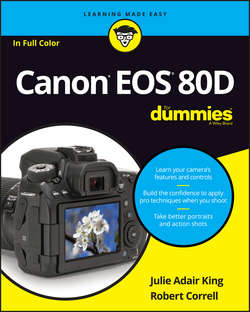Читать книгу Canon EOS 80D For Dummies - King Julie Adair - Страница 8
Part 1
Fast Track to Super Snaps
Chapter 1
Getting the Lay of the Land
Using the Touchscreen
ОглавлениеJust as cool as the monitor’s flexibility is its touchscreen interface. You can choose menu options, change picture settings, and scroll through your pictures by touching one or two fingers to the screen, just as you can with a tablet, smartphone, or other touchscreen device.
Throughout the book, we tell you exactly where and how to touch the screen to accomplish specific actions. For now, get acquainted with the terminology used to indicate these touchscreen moves, called gestures by those who feel the need to assign names to things such as this.
❯❯ Tap: Tap your finger on a screen item to select it. Give it a try: First, press the Menu button to display the menu screen on the monitor, as shown on the left in Figure 1-8. Along the top of the screen, you see one highlighted icon, representing the current menu, and a row of dimmed icons representing other menu categories. On the left side of Figure 1-8, Shooting Menu 1 is the current menu. To switch to another menu, tap its icon. For example, tap the icon for the Playback menu, labeled on the left in the figure, and that menu appears, as shown on the right. Beneath the top row of icons are numbered menus (also called secondary tabs or submenus), which allow options to be grouped under their main tab. Tap a number to switch to that numbered menu.
Tap gently – you don’t have to use force. To avoid damaging the screen, use the fleshy part of your fingertip, not the nail or any other sharp object, and be sure that your fingers are dry because the screen may not respond if it gets wet. Canon also advises against putting a protective cover over the monitor; doing so can reduce the monitor’s responsiveness to your touch.
❯❯ Drag: Drag your finger up, down, right, or left across the screen, according to our instruction. To try this gesture, first display Setup Menu 2 and tap LCD Brightness, shown on the left in Figure 1-9, to display the screen shown on the right. Now drag your finger across the scale at the bottom of the screen to adjust the screen brightness. Reset the marker to the middle of the bar after you’re done playing around – that setting gives you the most accurate indication of picture brightness.
On this particular screen, you also see icons at either end of the scale. You can tap those icons to raise or lower the value represented on the scale. Either way, tap the Set icon to implement the setting and return to the menu.
❯❯ Swipe: Drag a finger quickly across the screen. You use this gesture, known in some circles as a flick, to scroll through your pictures in Playback mode, a topic you can explore in Chapter 5.
❯❯ Pinch in/pinch out: To pinch in, place your thumb at one edge of the screen and your pointer finger at the other. Then drag both toward the center of the screen. To pinch out, start in the center of the screen and swipe both fingers outward. Pinching is how you zoom in and out on pictures during playback; again, Chapter 5 provides details.
FIGURE 1-8: Tap a menu icon to display its menu.
FIGURE 1-9: Tap the LCD Brightness item (left) and then drag left or right across a scale to adjust the setting (right).
You can control two aspects of touchscreen behavior:
❯❯ Touchscreen response: You can choose from three settings, accessed via the Touch Control option, found on Setup Menu 3 and shown in Figure 1-10.
● Standard: This setting is the default. The touchscreen is enabled and is set to respond to a “normal” amount of pressure. (Don’t ask us how the Powers That Be decided what that pressure level is – we don’t get invited to those conferences.)
● Sensitive: This setting makes the touchscreen more, er, touchy. That is, it responds to lighter pressure. Oddly, though, Canon says that the camera may be slower to respond to a very quick tap at this setting. Your mileage may vary.
● Disable: Select this setting to disable the touchscreen function.
To restore the touch function, press the Menu button to bring up the menu screens and then rotate the Main dial – that’s the one just behind the shutter button – to select Setup Menu 3. Then rotate the Quick Control dial (the big wheel on the back of the camera) to highlight Touch Control. Press the Set button, rotate the Quick Control dial to highlight Standard or Sensitive, and press the Set button again.
❯❯ Touchscreen sound effects: By default, the camera emits a little “boop” sound every time you tap a touch-controlled setting. If you’re sick of hearing it, visit Shooting Menu 1 and look for the Beep setting, shown in Figure 1-11. The option that disables the boop is Touch to Silence – silence being indicated by a little speaker with a slash through it. The Disable setting turns off both the touchscreen sound and the normal beep tone that occurs when the camera finds its focus point.
FIGURE 1-10: Control the touchscreen response through this menu item.
FIGURE 1-11: Set the Beep option to Touch to Silence to prevent the camera from making a sound when you tap a touch-controlled item.
One final point about the touchscreen: If you connect the camera to a TV or monitor, the touchscreen has limited functionality when you are playing back photos and movies (scrolling and zooming). Otherwise, it is no longer is available, regardless of the Touch Control option. Don’t fret; you just have to use the old-fashioned button-push method of selecting menu options. See “Ordering from Camera Menus,” later in this chapter, if you need help.
